Gallery opened 13 Apr 2015
Updated: 11 June 2015
More on Diesel & Pawlikowsky






Solid Fuel IC Engines |
Gallery opened 13 Apr 2015 |
The obvious solid fuel is coal. It is much more abundant than oil, and so there have been many attempts to run petrol or diesel-type engines on pulverised coal. Interest waxes and wanes as the price of oil changes. There are fundamental problems; pulverised coal is highly abrasive, and it contains a percentage of ash that tends accumulate in the engine. The amount of ash varies with the type of coal, thus: anthracite 10 - 20%, bituminous coal 3 - 12%, sub-bituminous coal up to 10%, lignite 10 - 50%. Whatever sort of coal you use there are going to be substantial amounts of ash to deal with.
MEDHURST'S GUNPOWDER ENGINE
An early practical difficulty with the internal combustion engine was getting hold of a suitable fuel. Before petroleum products were available, various expedients were tried such as turpentine. However, there was a substance which was fairly readily available, and on ignition could be relied upon to produce a lot of hot gas. That substance was gunpowder. What could possibly go wrong?
George Medhurst, was a clockmaker in Pleasant Row, Clerkenwell. in London. In 1800 he was granted a patent for a "New Improved Method of Driving Carriages of All Kinds, without the Use of Horses, by means of an improved Aeolian engine..." which was British patent No 2431 for that year. (Patent numbering started from zero for each year in those days) This was essentially an ambitious proposal to cover the country with windmill-driven pumps that would charge reservoirs with compressed air, to drive vehicles; the gun-powder engine appeared on only one of the ten pages. This was 24 years before Sadi Carnot considered coal dust as a possible solid fuel.
Graces Guide has much more information on the career of George Medhurst.
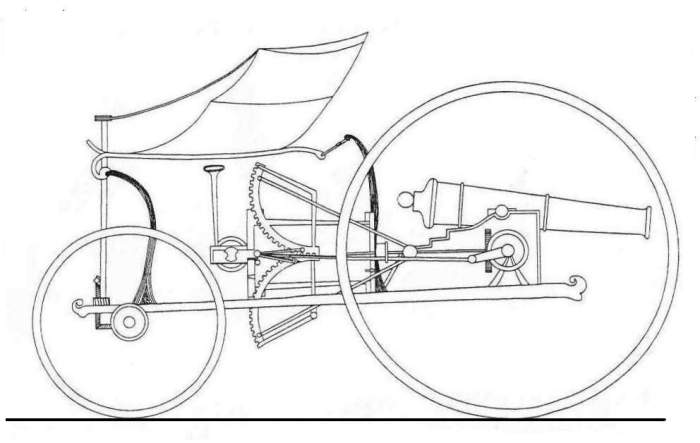 | Left: Medhurst's gunpowder-powered gun carriage: 1800
|
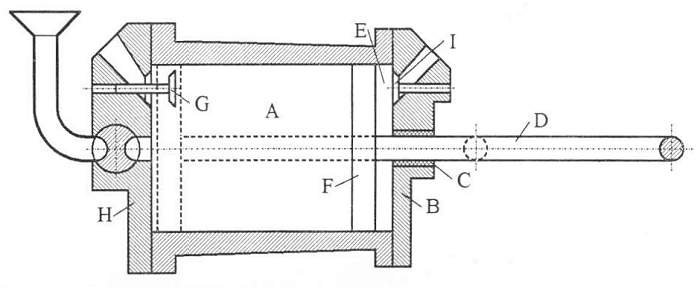 | Left: The cylinder of Medhurst's gunpowder engine
|
When the explosion occurred, the piston F would move to the right, and the inventor expected such a high expansion ratio that with the piston fully to the right the pressure would be sub-atmospheric and valve G would be forced open by the outside pressure. When the piston moved left again the exhaust gases would be pushed out of G until the piston reached it and closed it. Gunpowder does not need an external air supply to explode, as it carries oxygen with it in the potassium nitrate, so there was no need to draw in a fresh charge of air.
The rightmost part of the cylinder was closed off with a cover B, and in conjunction with valve I was supposed to provide an air cushion to absorb the shock of the gunpowder explosions; as described, it is unlikely this could have worked.
Medhurst recommended that the charge per working cycle be 1/15 of a cubic inch of gunpowder to generate one horsepower. Since this would require an overall efficiency of 27%, completely impossible at the time, it seems unlikely that Medhurst carried out any practical tests of the gunpowder engine.
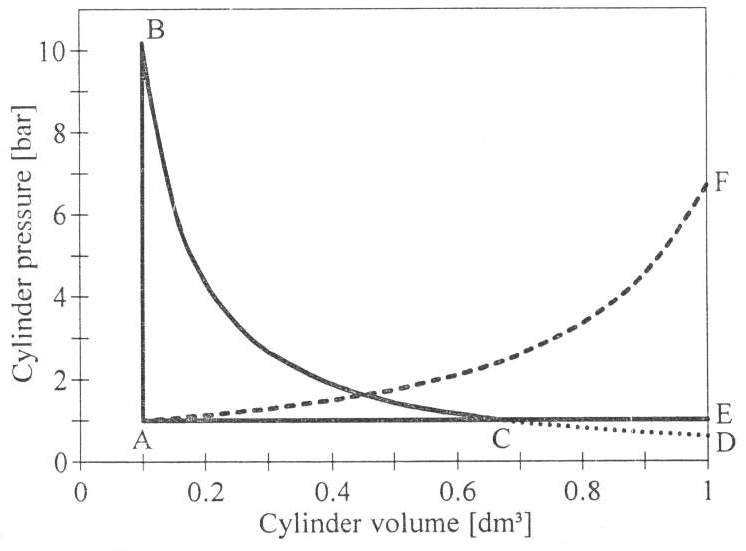 | Left: Speculative indicator diagram for Medhurst's gunpowder engine
|
Looking critically at Medhurst's idea, could it have been made to work at all? There are objections:
1) The rotating cock that delivers the gunpowder charge makes me uneasy. It would seem to be all too easy for friction to ignite both the measured charge and the ready-use store of gunpowder in the small funnel.
2) When gunpowder burns, it does not turn completely into gas; about 55% by weight is solid, mainly potassium carbonate, potassium sulphate, and potassium sulfide. This causes musket fouling; a major factor in warfare for centuries. If the residues built up in musket barrels, there seems no reason why they would not build up in the cylinder here. The highly dubious ignition mechanism proposed would seem to be particularly vulnerable to this.
At the moment this is the only engine known to the Museum which actually uses an explosive as its fuel. Gunpowder is a low explosive; it burns relatively slowly, at subsonic speeds of propagation, as opposed to high explosives that detonate, producing supersonic shock waves. Nitroglycerine, for example, detonates producing shock waves through itself travelling at some 30 times the speed of sound; decomposition into a white-hot gas is near-instantaneous. The gases generated occupy more than 1200 times the original volume of explosive at ordinary room temperature and pressure, and the gas temperature is about 5000°C (9030°F). This is very different from burning, which depends upon available fuel regardless of pressure or shock. Considering these figures, a nitroglycerine engine might produce a lot of power in a small space, but somehow I am still not keen on the idea. Obviously it's crazy- I wonder how long a direct-injection nitroglycerine engine would run for?
And yet... you can bet that some people want to try it. See this suggestion from 2012. They also considered the notion at the HalfBakery in 2002.

SADI CARNOT
The first known consideration of coal dust as a fuel was by the great French scientist and pioneer thermodynamicist Sadi Carnot in 1824, according to an article by Hans-Joachim Braun "The Coal Dust Motor 1916-1940" under the auspices of the Deutsches Museum, Munich.

SOME EARLY ATTEMPTS
According to the Braun article:
"The oldest known documentation regarding coal dust engines is an American patent from 1851 which described a type of coal dust turbine (2). In the period between 1890 and 1913 the Englishman McCullum worked through the development of coal dust engines and developed several versions, one of which was exhibited in Glasgow in 1901. He said that the fire safety regulations were the greatest hindrance to his progress (3)."
Neither the American patent nor any trace of Mr McCullum have been found. It is hard to see how British fire safety regulations would have hampered the work much, unless they (very sensibly) discouraged the storage of large amounts of pulverised coal, which is liable to self-heating and self-ignition.
References in the Braun article are to documents by Hans Wahl, who wrote a book called Verschleißbekämpfung bei Staubmotoren (Roughly: The Control of Wear in Dust Engines) in 1936. Dr. Ing. Hans Wahl studied at the University of Stuttgart Mechanical Engineering. In 1924 he took his first job in the chemical industry, where he was involved in the development of anti-knock agent for truck engines. From 1934 he was concerned with engine wear as part of the development of the RUPA coal dust motor; see below.
RUDOLF DIESEL AND COAL-DUST
It is well-known that Diesel's early experiments were done using coal-dust as a fuel. Rudolf Pawlikowsky was one of his assistants, Vogel another. The usual account states that in 1892 an experiment with coal-dust as a fuel blew the compression indicator violently off the side of the cylinder, it shooting between Diesel and his assistant Vogel, and smashing into a wall. This incident is often reported as the complete destruction of the engine and the severe wounding of Diesel, but this appears to be mere exaggeration. One contributor to this site claims Diesel was killed! This would have slowed down the development of the Diesel engine somewhat.
For what actually happened, here is the account by Diesel himself, from his book " The Origin of the Diesel Engine" Springer, 1913:
"In spite of the lack of compression on the 10th August 1893, 20 days after the start of the experiments, with the engine driven by the line shafting and in the presence of my friend Vogel the first injection of fuel, which was Petrol was undertaken. We both awaited the results in tense anticipation."
So in this incident the fuel was petrol, not coal dust, and the engine was being motored by an external power source rather than running by itself. This affair had nothing to do with abandoning coal-dust as a fuel. The problem with coal was not the pressures it created, but the abrasion in the engine; this is why Diesel turned to liquid fuel.

"Ignition happened immediately, Diagram No. 1 showed an explosion pressure up to 80 atmospheres"
In reality the pressure was somewhat higher, the indicator was destroyed by the powerful explosion and flew past our heads. Nothing happened to the engine, as very high pressures were anticipated and it was built like a cannon."
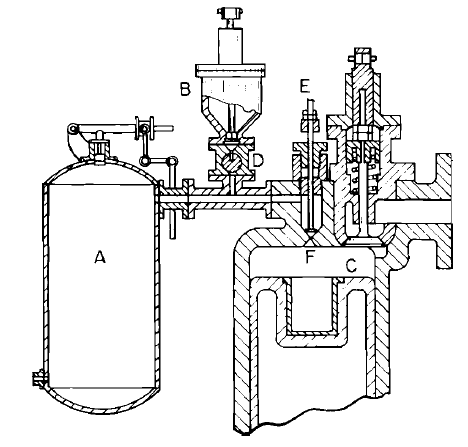 | Left: Diesel's coal-dust injection system
|
Working for Diesel must have been a frustrating business for Vogel and Pawlikowsky. Diesel insisted on patenting their ideas as his own, which is hardly a recipe for harmony. A dispute of this sort caused Pawlikowsky to resugn from the Diesel project in 1898.
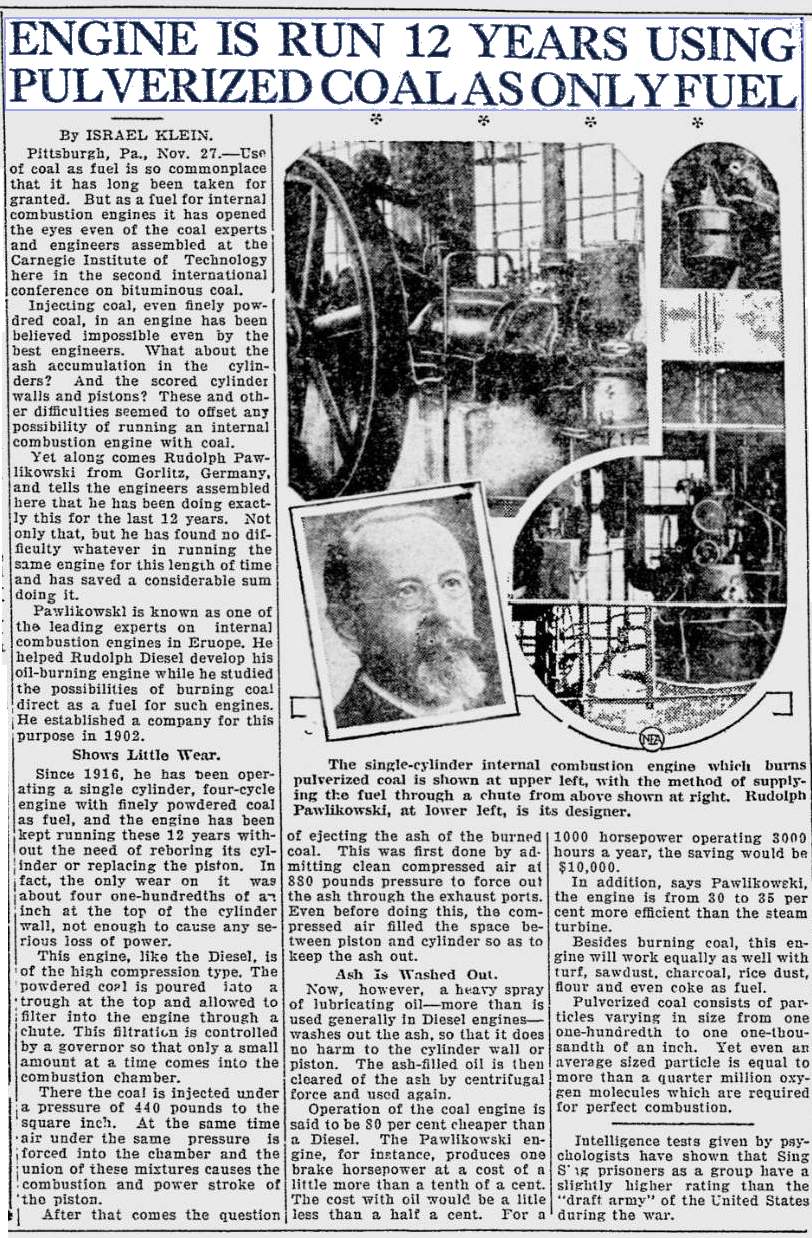
| Left: Newspaper article on Pawlikowsky's engine
|
Pawlikowsky took four letters of his name and called it the Rupa engine. It was intended that its main use would be in peak-lopping electricity generating stations, as the engines could be started and stopped much more quickly than steam plant. It does not appear to have had any commercial success, but the Museum staff are continuing their enquiries.
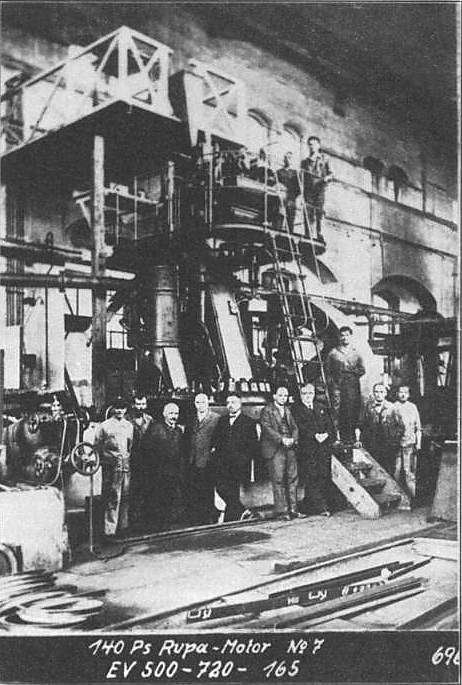 | Left: This is Pawlikowsky's engine No 7: 1930
|
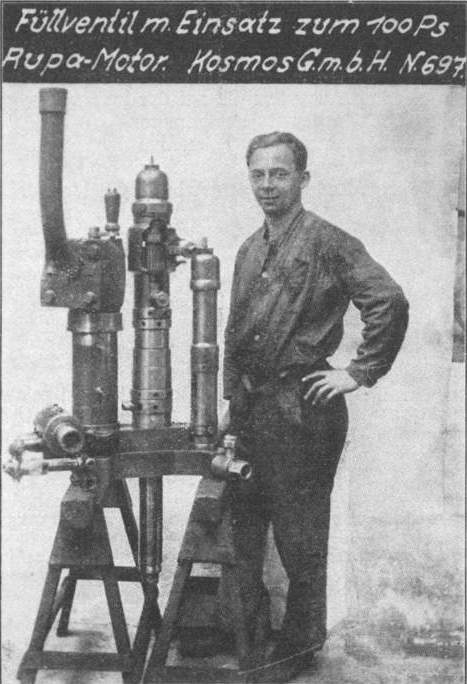 | Left: The fuel valve assembly for one of Pawlikowsky's engines
|
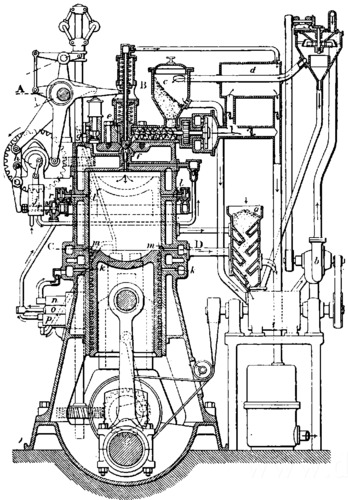 | Left: Section of one of Pawlikowsky's RUPA engines
|
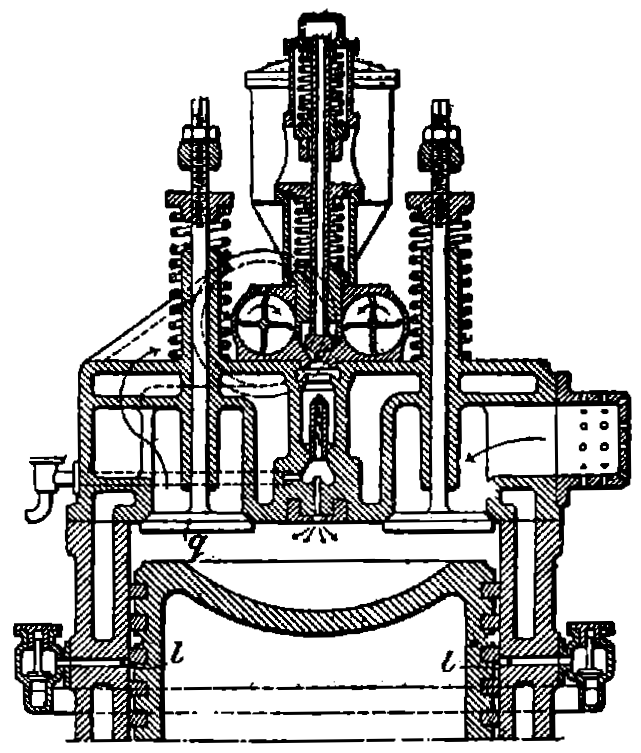 | Left: Cylinder head of one of Pawlikowsky's RUPA engines
|
In 1933 Pawlikowski took out US patent 1 926 304 "Powdered fuel for internal combustion engines" which specified the addition of a more combustible material to the coal-dust. Little detail about the engines is given, but it adds 'wood-meal, fallen leaves, animal carcasses' to the list of possible fuels.
In September 1939 German forces occupied Romanian territory to sieze the oil-fields of Ploiesti under the pretext of protecting the oil resources, and coal-dust engine abruptly became less relevant.

This article appeared in The Commercial Motor, 29th August 1941, when the security of oil supplies was no doubt on everyone's mind:
"Before Dr Diesel succeeded in running an engine on oil fuel he had failed in experiments with powdered coal.. That was over 40 years ago, as is indicated by the following note which appeared in a technical paper dated May 15, 1897: " A German engraver named Diesel has designed and brought out a new pattern motor. In this he has, it is stated, had the financial assistance of the great firm of Krupp. It is elaiined that the engine can run on oil, gas or coal dust." Coal dust, being something new in fuels in those early years, was put in italics.""This is probably the starting of the interest in coal dust, powdered coal or pulverized fuel. its progress was very slow,and did not continue along the first line of application, namely, employment in an internal combustion engine. Diesel's difficulties were so great that he soon deserted this type of fuel and switched over to heavy oils of the hydrocarbon series, with the successful results of which we ale all aware." "Abrasion of Cylinder Walls: his troubles centred on the apparent impossibility of preventing the ash in the coal, released by combustion, from causing excessive wear of the cylinder walls. This would surprise few of us, thinking of the amount of ash that falls out of a fire grate, even with the best of coals." "Further, when we consider that the ash content of oil fuel to-day is a fraction of 1 per cent- it would not have been much higher in those days— and that it is a good coal that has as little as 4 per cent, most brands being of 10 per cent, and upwards, to 25 per cent. and over, we can visualize his troubles." "The success of Diesel on oil was such that he never returned to his experiments on pulverized fuel. It is regrettable that his early death prevented him from participating to the full in the wonderful developments springing from his genius and energy." "After a lapse of some years, one at least of Diesel's associates took up the dropped experiments and carried them through to a successful issue. Not, however, to the extent that road transport can participate using the system. It is in the realm of stationary engines that progress has been made." "Reports have appeared from time to time in the Technical Press of the developments with an engine referred to as the "Rupa" made by a German concern under the direction of Mr. Pawlikovvsky, (sic) the co-experimenter with Diesel in the early researches, referred to above. Experiments in recent years have been carried out on brown coal, of which so much is available in Germany: The principle of operation of the Rupa engine is that of pre-combustion of the fuel in an ante-chamber, the pressure therein generated injecting the unconsumed fuel into the main cylinder. This system also minimizes the possibilities of ash trouble." "In the pulverizing of the fuel, the ash content can be lowered to between 2 and 3 per cent. It is possible to bring it down to 1 per cent, but the cost of doing this has to be weighed against the requirements of such fuel, and the operation is usually carried so far only for certain purposes or processes." "Coal's Advantage on Points: With oil at from three to four times the cost of coal, and allowing for the difference of calorific values in favour of oil (oil 19,500 BThU; coal 14,000 BThU, per lb.) and the cost of liner renewal as a result of ash wear, pulverized coal appears to hold the possibility of successful competition with oil in oil's sphere of activity." |
The article is not exactly bursting with hard facts, probably because of its 1941 wartime provenance, but it does give some perspective. In fact, Pawlikowski's research appears to have been abandoned around this time.
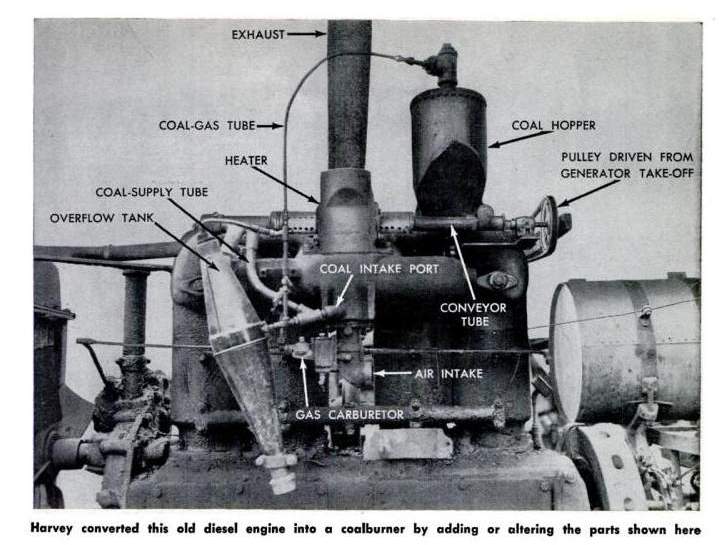 | Left: Petrol engine allegedly converted to powdered coal: 1956
|
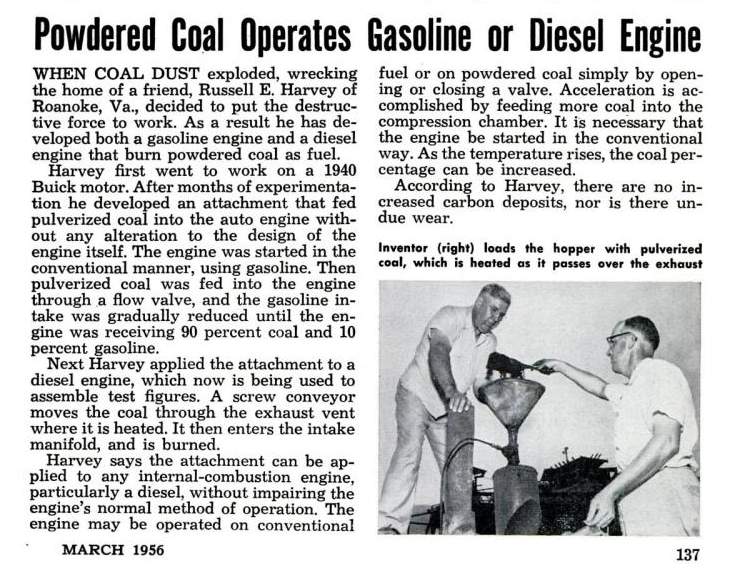 | Left: Account of engines converted to powdered coal: 1956
|

PATENTS
This is a list of patents that I have come across in researching this subject. It is not in any way complete, and omits patents after 1970.

   
|